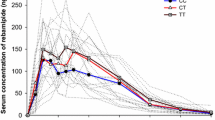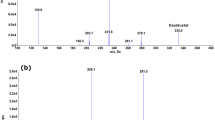Summary
The influence of phenotype (debrisoquine type of oxidation polymorphism) and quinidine on (±)-metoprolol distribution parameters was investigated in 7 young male volunteers (4 extensive and 3 poor metabolisers). (±)-Metoprolol tartrate 20 mg was administered as a 20 min infusion i) alone, ii) 12 h after an oral 50 mg quinidine sulphate capsule, and iii) on the last day of 3 days of treatment with 250 mg quinidine sulphate b. d. as a slow-release tablet.
No stereoselectivity was apparent in either poor or extensive metabolizers. When (±)-metoprolol was administered alone the apparent volume of distribution at steady-state (Vss) was higher in extensive than in poor metabolisers (4.84 vs 2.83 1·kg−1, respectively). Pre-treatment with low or multiple high doses of quinidine decreased Vss in extensive metabolisers to values comparable to those in poor metabolisers (3.50 and 3.18 l·kg−1, respectively), but had no significant effect in poor metabolisers (3.24 and 3.42 l·kg−1, respectively). Estimation of Vss by noncompartmental analysis or assuming elimination exclusively from the peripheral compartment yielded similar, although somewhat higher, estimates.
Despite the small number of subjects, (±)-metoprolol distribution appeared to be different both in genetically and environmentally (quinidine)-determined poor metabolisers, and quinidine inhibition was a good, reversible in vivo model of the genetic deficiency in handling (±)-metoprolol. Differences both in first pass pulmonary elimination or in tissue binding are logically consistent with these observations, but the amplitude of the effect exceeds expections from available biological evidence on selective pulmonary metabolic activity and on specific tissue binding sites.
Similar content being viewed by others
References
Mahgoub A, Dring LG, Idle JR, Lancaster R, Smith RL (1977) Polymorphic hydroxylation of debrisoquine in man. Lancet II: 584–586
Meyer UA, Skoda RC, Zanger UM (1990) The genetic polymorphism of debrisoquine/sparteine metabolism — molecular mechanisms. Pharmacol Ther 46: 297–308
Eichelbaum M, Gross AS (1990) The genetic polymorphism of debrisoquine/sparteine metabolism — Clinical aspects. Pharmacol Ther 46: 377–394
Mikus G, Ha HR, Vozeh S, Zekorn C, Follath F, Eichelbaum M (1986) Pharmacokinetics and metabolism of quinidine in extensive and poor metabolisers of sparteine. Eur J Clin Pharmacol 31: 69–72
Guengerich FP, Müller-Enoch D, Blair IA (1986) Oxidation of quinidine by human liver cytochrome P-450. Mol Pharmacol 30: 287–295
Otton SV, Inaba T, Kalow W (1984) Competitive inhibition of sparteine oxidation in human liver by beta-adrenoceptor antagonists and other cardiovascular drugs. Life Sci 34: 73–80
Leemann T, Dayer P, Meyer UA (1986) Single-dose quinidine treatment inhibits metoprolol oxidation in extensive metabolizers. Eur J Clin Pharmacol 29: 739–741
Otton SV, Crewe HK, Lennard MS, Tucker GT, Woods HF (1988) Use of quinidine inhibition to define the role of the sparteine/debrisoquine cytochrome P450 in metoprolol oxidation by human liver microsomes. J Pharmacol Exp Ther 247: 242–247
Zhou HH, Anthony LB, Roden DM, Wood AJJ (1990) Quinidine reduces clearance of (+)-propranolol more than (−)-propranolol through marked reduction in 4-hydroxylation. Clin Pharmacol Ther 47: 686–693
Hamilton RA, Kowalsky SF, Wright EM, Cernak P, Benziger DP, Stroshane RM, Edelson J (1986) Effect of the acetylator phenotype on amrinone pharmacokinetics. Clin Pharmacol Ther 40: 615–619
Price-Evans DA, Mahgoub A, Sloan TP, Idle JR, Smith RL (1980) A family and population study of the genetic polymorphism of debrisoquine oxidation in a white British population. J Med Genet 17: 102–105
Dayer P, Balant L, Courvoisier F, Küpfer A, Kubli A, Gorgia A, Fabre J (1982) The genetic control of bufuralol metabolism in man. Eur J Drug Metab Pharmacokinet 7: 73–77
Schmid B, Bircher J, Preisig R, Küpfer A (1985) Polymorphic dextromethorphan metabolism: Co-segragation of oxidative O-demethylation with debrisoquin hydroxylation. Clin Pharmacol Ther 38: 618–624
Devi KP, Rao KVR, Baveja SK, Leemann T, Dayer P (1988) Determination of alprenolol and metoprolol in plasma by column liquid chromatography. J Chromatogr 434: 265–270
Leemann T, Dayer P (1988) Simultaneous enantioselective determination of underivatized beta-blocking agents and their metabolites in biological samples by chiral ion-pairing high-performance liquid chromatography. In: Stevenson D, Wilson ID (eds) Chiral Separations. Plenum, London, pp 71–78
Sheiner LB (1983) ELSFIT (version 3.0). A program for the Extended Least Squares Fit to individual pharmacokinetic data (Users manual). University of California, Division of Clinical Pharmacology, San Francisco
Aronson JK, Dengler HJ, Dettli L, Follath F (1988) Standardisation of symbols in clinical pharmacology. Eur J Clin Pharmacol 35: 1–7
Collier PS (1983) Some considerations on the estimation of steady-state apparent volume of distribution and the relationship between volume terms. J Pharmacokinet Biopharm 11: 93–105
Lennard MS, Tucker GT, Silas JH, Freestone S, Ramsay LE, Woods HF (1983) Differential stereoselective metabolism of metoprolol in extensive and poor debrisoquin metabolizers. Clin Pharmacol Ther 34: 732–737
DiStefano III JJ (1982) Noncompartmental vs. compartmental analysis: some bases for choice. Am J Physiol 243: R1-R6
DiStefano III JJ, Landaw EM (1984) Multiexponential, multi-compartmental, and noncompartmental modeling. I. Methodological limitation and physiological interpretations. Am J Physiol 246: R651-R664
Landaw EM, DiStefano III JJ (1984) Multiexponential, multi-compartmental, and noncompartmental modeling. II. Data analysis and statistical considerations. Am J Physiol 246: R665-R677
Benet LZ (1972) General treatment of linear mammillary models with elimination from any compartment as used in pharmacokinetics. J Pharm Sci 61: 536–541
Nakashima E, Benet LZ (1988) General treatment of mean residence time, clearance, and volume parameters in linear mammillary models with elimination from any compartment. J Pharmacokinet Biopharm 16: 475–492
Nakashima E, Benet LZ (1989) An integrated approach to pharmacokinetic analysis for linear mammillary systems in which input and exit occur in/from any compartment. J Pharmacokinet Biopharm 17: 673–686
Chiou WL (1989) The phenomenon and rationale of marked dependence of drug concentration on blood sampling site: Implications in pharmacokinetics, pharmacodynamics, toxicology and therapeutics, part I. Clin Pharmacokinet 17: 175–199
Chiou WL (1989) The phenomenon and rationale of marked dependence of drug concentration on blood sampling site: implications in pharmacokinetics, pharmacodynamics, toxicology and therapeutics, part II. Clin Pharmacokinet 17: 275–290
Weiss M (1991) Nonidentity of the steady-state volumes of distribution of the eliminating and noneliminating system. J Pharm Sci 80: 908–910
Eap CB, Cuendet C, Baumann P (1988) Selectivity in the binding of psychotropic drugs to the variants of alpha-1 acid glycoprotein. Naunyn-Schmiedeberg's Arch Pharmacol 337: 220–224
Zanger UM, Vilbois F, Hardwick JP, Meyer UA (1988) Absence of hepatic cytochrome P450buf1 causes genetically deficient debrisoquine oxidation in man. Biochemistry 27: 5447–5454
Gut J, Catin T, Dayer P, Kronbach T, Zanger U, Meyer UA (1986) Debrisoquine/sparteine-type polymorphism of drug oxidation. Purification and characterization of two functionally different human liver cytochrome P-450 isozymes involved in impaired hydroxylation of the prototype substrate bufuralol. J Biol Chem 261: 11734–11743
Gut J, Gasser R, Dayer P, Kronbach T, Catin T, Meyer UA (1984) Debrisoquine-type polymorphism of drug oxidation: purification from human liver of a cytochrome P450 isozyme with high activity for bufuralol hydroxylation. FEBS Lett 173: 287–290
Author information
Authors and Affiliations
Additional information
This work was presented in part at the Ninety-first Annual Meeting of the American Society for Clinical Pharmacology and Therapeutics, San Francisco, CA, March 1990
Rights and permissions
About this article
Cite this article
Leemann, T.D., Devi, K.P. & Dayer, P. Similar effect of oxidation deficiency (debrisoquine polymorphism) and quinidine on the apparent volume of distribution of (±)-metoprolol. Eur J Clin Pharmacol 45, 65–71 (1993). https://doi.org/10.1007/BF00315352
Received:
Accepted:
Issue Date:
DOI: https://doi.org/10.1007/BF00315352




